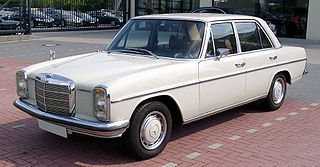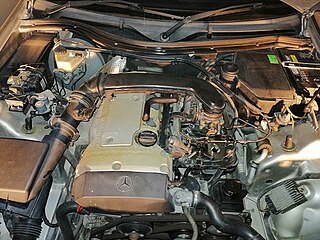Related Research Articles

The Mercedes-Benz E-Class is a range of executive cars manufactured by German automaker Mercedes-Benz in various engine and body configurations. Produced since 1953, the E-Class falls midrange in the Mercedes line-up, and has been marketed worldwide across five generations.

The Mercedes-Benz M112 engine is a gasoline-fueled, 4-stroke, spark-ignition, internal-combustion automobile piston V6 engine family used in the 2000s. Introduced in 1996, it was the first V6 engine ever built by Mercedes. A short time later the related M113 V8 was introduced.

The Mercedes-Benz W114 and W115 are the internal designations Mercedes-Benz used for a generation of front-engine, rear-drive, five-passenger sedans and coupés introduced in 1968, with three-box styling by Paul Bracq — succeeding the W110 models introduced in 1961; and manufactured until model year 1976, when the W123 was released.

The Mercedes-Benz W124 is a range of executive cars made by Daimler-Benz from 1984 to 1997. The range included numerous body configurations, and though collectively referred to as the W-124, official internal chassis designations varied by body style: saloon (W 124); estate (S 124); coupé (C 124); cabriolet (A 124); limousine (V 124); rolling chassis (F 124); and long-wheelbase rolling chassis (VF 124).

The Mercedes-Benz W211 is the third generation Mercedes-Benz E-Class made from 2001 to 2009 in sedan/saloon and station wagon/estate configurations – replacing the W210 E-Class models and superseded by the Mercedes-Benz W212 in 2009.

The second generation CL-Class used the C215-chassis designation and was manufactured and marketed by Mercedes from 1998–2006 as the company's flagship model, a two-door, four-passenger coupé.

The OM617 engine family is a straight-5 diesel automobile engine from Mercedes-Benz used in the 1970s and 1980s. It is a direct development from the straight-4 OM616. It was sold in vehicles from 1974 to 1991. The OM617 is considered to be one of the most reliable engines ever produced with engines often reaching over 1,000,000 km (620,000 mi) without being rebuilt and is one of the key reasons for Mercedes' popularity in North America in the 1980s, as it was powerful and reliable compared to other automotive diesels of the time. It is also a very popular choice for the use of alternative fuels, mainly straight or waste vegetable oil and biodiesel, although the use of these fuels may cause engine damage over time if not processed properly before use.

The Mercedes-Benz W126 is a series of passenger cars made by Daimler-Benz AG. It was marketed as the second generation of the Mercedes-Benz S-Class, and manufactured in sedan/saloon (1979–1991) as well as coupé (1981–1990) models, succeeding the company's W116 range. Mercedes-Benz introduced the 2-door C126 coupé model, marketed as the SEC, in September 1981. This generation was the first S-Class to have separate chassis codes for standard and long wheelbases and for coupé (C126).

The M111 engine family is a straight-4 automobile engine from Mercedes-Benz, produced from 1992 to 2003. Debuted in the 1992 Mercedes-Benz E-Class (W124), this engine family is relatively oversquare and uses 4 valves per cylinder. All engines in the family use a cast iron engine block and aluminum alloy cylinder head.

The Mercedes-Benz 540K (W29) is a grand touring car built by the German firm Mercedes-Benz between 1936 and 1940.

The Mercedes-Benz W 153 was a luxury six cylinder passenger car built in parallel with the W 143 from 1938, and first presented in public at the Berlin Motor Show early in 1939. It was one of several Mercedes-Benz models known, in its own time, as the Mercedes-Benz 230.

Mercedes-Benz W202 is the internal designation for a compact sedan/saloon manufactured and marketed by Mercedes-Benz between 1992–2001, as the first generation of the C-Class, now in its fifth generation. Replacing the 190 series/W201 in June 1993, the C-Class sedan was Mercedes' entry-level model until 1997, when the company launched the A-Class. Production reached 1,847,382 over model years 1994–2000.
The Mercedes-Benz M142 engine is a naturally-aspirated, 3.2-liter to 3.4-liter, straight-6, internal combustion piston engine, designed, developed and produced by Mercedes-Benz; between 1937 and 1942.
The Mercedes-Benz M143 engine is a naturally-aspirated, 2.2-liter, straight-6, internal combustion piston engine, designed, developed and produced by Mercedes-Benz; between 1936 and 1941.
The Mercedes-Benz M21 engine is a naturally-aspirated, 2.0-liter, straight-6, internal combustion piston engine, designed, developed and produced by Mercedes-Benz; between 1933 and 1936.
The Mercedes-Benz M11 engine is a naturally-aspirated, 2.6-liter, straight-6, internal combustion piston engine, designed, developed and produced by Mercedes-Benz; between 1929 and 1935.
The Mercedes-Benz M09 engine is a naturally-aspirated, 3.4-liter, straight-6, internal combustion piston engine, designed, developed and produced by Mercedes-Benz; between 1928 and 1929.
The Daimler-Mercedes M9456 engine is a supercharged and naturally-aspirated, 6.2-liter to 6.4-liter, straight-6, internal combustion piston engine, designed, developed and produced by Mercedes-Benz, in partnership with Daimler; between 1924 and 1929.
The Daimler-Mercedes M836 engine is a naturally-aspirated and supercharged, 3.9-liter to 4.0-liter, straight-6, internal combustion piston engine, designed, developed and produced by Mercedes-Benz, in partnership with Daimler; between 1924 and 1929.
References
- ↑ "1938 Mercedes-Benz 230 SV Sport W 153 specifications | technical data | performance | fuel economy | emissions | dimensions | horsepower | torque | weight". Carfolio.com. Retrieved 9 November 2021.
- ↑ "Mercedes-Benz M153 Engine". Sportlichleicht.com. Retrieved 9 November 2021.
- ↑ "230 (W 153), 1938 - 1943". Mercedes-benz-publicarchive.com. Retrieved 9 November 2021.
- ↑ "230 SV (M 153 engine)". Mercedes-benz-publicarchive.com. Retrieved 9 November 2021.
- ↑ Oswald, Werner. Deutsche Autos 1920–1945[German Cars 1920–1945] (in German). Vol. 2. p. 255.